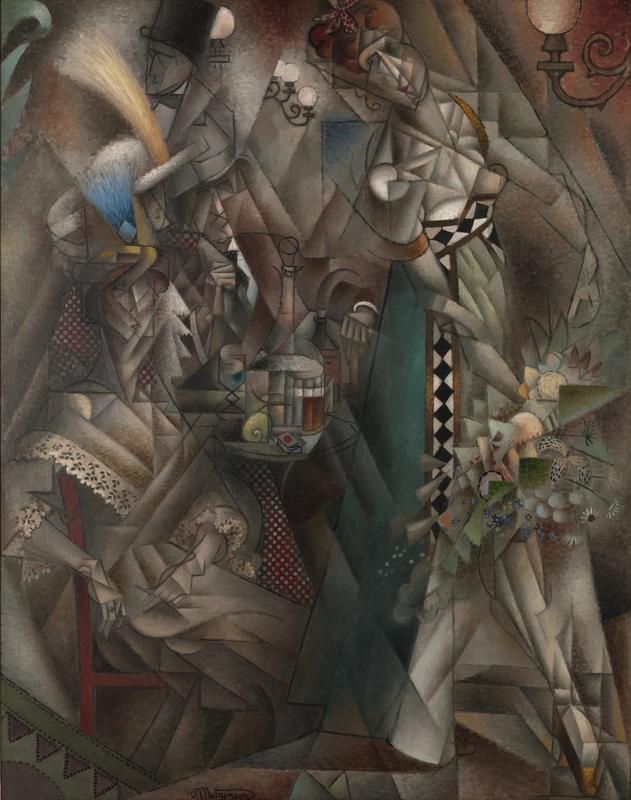More about Dancer in a Café

Sr. Contributor
In 1912, Dancer in a Cafe by Jean Metzinger was at the center of a public controversy when it premiered at the Salon D’Automne in Paris.
In recent years, there have been several protests against public art and in most cases the protests centered around unequal representation of minority artists, cultural erasure, or hating on Renoir. So it may sound baffling that a little over a century ago and half a world away, public outcry had quite a different focus: Cubism.
Sparks ignited when a letter sent by a Mr. Lampué reached the Chambre des Députés. He wrote that the public was leaving the Salon D’Automne “disgusted” and likened Cubists to crooks behaving as “gangsters” in the art world. Thus, it became a matter of public debate: should public funds be utilized for displaying Cubist art?
The controversy can be traced back a year earlier to the “Room 41” scandal of 1911. A group of Cubist artists, including Metzinger, worked their way onto the hanging committee at the Salon des Indépendants. The art pieces were supposed to be displayed in alphabetical order by the artist’s name but the “Salon Cubists”, as they would later be called, had other plans. They displayed all of the Cubist art together in room 41. It became an art hanging scandal, the Salon Cubists became infamous as they succeeded in getting lots of publicity and generally pissing off the conservative Parisian population.
The word “Cubism” actually comes from a review of an early painting of George Braque by critic Louis Vauxcelles. It was in no way intended as a compliment and the press began using the term as a derogatory descriptor. But Metzinger and fellow artist Albert Gleizes adopted the word and proudly call themselves Cubists.
Metzinger and Vauxcelles were never on good terms and after the 1912 Salon D’Automne tensions between them worsened to an almost deadly degree. A duel was proposed between them with someone else acting as Vauxcelles’ substitute. Gleizes prevented the duel before any guns could be raised and even went on to stop Vauxcelles from another duel later on. The guy clearly loved making enemies.
There were other critics who viewed Metzinger’s work and didn’t express a desire to kill him; the three paintings he displayed at the Salon D’Automne even received positive reviews. Dancer in a Cafe in particular stood out. The level of detail put into the clothing on the figures in the painting is as thorough as a costume rendering. One reviewer noted that the meticulous detail of the garments showed Metzinger had a love of modern fashion, particularly styles by designer Paul Poiret.
Metzinger and Poiret had quite a lot in common. Both of them loved embracing modern styles and neither of them had friends among conservative Parisians. Poiret started his career as a fashion designer at the House of Worth, a large Paris fashion house. The conservative clientele of the House of Worth weren’t interested in Poiret’s modern designs, so he went on to make his own studio.
Perhaps if Mr. Lampué had controlled his nausea long enough to look past the fragmentation of Dancer in a Cafe he might have a few complaints to add to his letter. Namely about Metzinger’s depiction of modern, uncorseted silhouettes.
Sources
- Brooke, Peter. Albert Gleizes: For and against the Twentieth Century. New Haven: Yale University Press, 2001.
- Cottington, David. Cubism and Its Histories. Manchester: Manchester University Press, 2004.
- Koda, Harold, and Andrew Bolton. Poiret. New York: Metropolitan Museum of Art, 2005.
- Leighten, Patricia Dee. The Liberation of Painting: Modernism and Anarchism in Avant-guerre Paris. Chicago: University of Chicago Press, 2018.
- Wallis, Jeremy. Cubists. Chicago, IL: Heinemann Library, 2003.
Featured Content
Here is what Wikipedia says about Dancer in a Café
Dancer in a Café (also known as Danseuse au café or Au Café Concert and Danseuse) is an oil painting created in 1912 by the French artist and theorist Jean Metzinger. The work was created while Metzinger and Albert Gleizes, in preparation for the Salon de la Section d'Or, were publishing, Du "Cubisme", the first major defense of the Cubist movement, and it was first displayed (under the title Danseuse) at the 1912 Salon d'Automne in Paris. The work proved controversial within the Municipal Council of Paris, causing debate in the Chambre des Députés about the use of public funds to exhibit such 'barbaric' art, with the Cubists being defended by the Socialist deputy Marcel Sembat.
Dancer in a Café was first reproduced in a photograph published in an article entitled Au Salon d'Automne "Les Indépendants" in the French newspaper Excelsior, 2 Octobre 1912. The painting is now located at the Albright-Knox Art Gallery, Buffalo New York.
Check out the full Wikipedia article about Dancer in a Café












